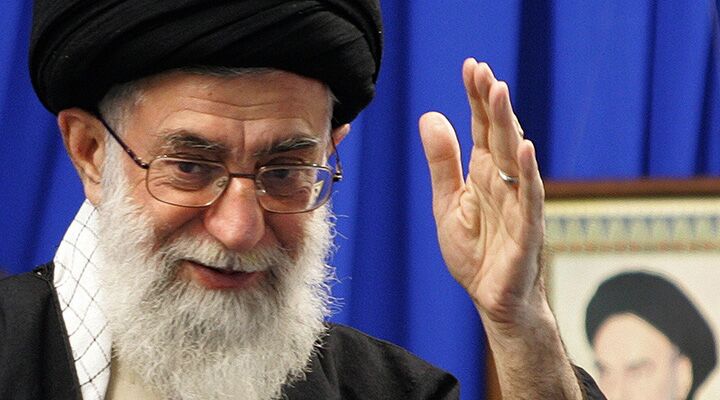
More Missiles, Less Talk
Just how does Iranian Supreme Leader Ayatollah Ali Khamenei see Iran growing from strength to strength in the future? According to his speech on March 30, he has a clear path forward—and it isn’t forged with diplomacy.
Attacking his opponents at home, Khamenei said, “Those who say the future is in negotiations, not in missiles, are either ignorant or traitors.”
Launched on the ayatollah’s official website, the statement was a dig at former President Akbar Rafsanjani, who tweeted that “the future is in dialogue, not missiles.”
Khamenei’s speech simultaneously condemns the ever hopeful White House.
United States President Barack Obama and his top nuclear negotiators have continually touted the Iran nuclear deal as a major success, proof that Iran is undergoing some sort of miraculous political metamorphosis. The “moderates” in Iran can say what they want, but the fact is, the ayatollah’s words are actually backed with action.
Since the nuclear deal was signed, Iran has repeatedly violated missile sanctions. In early March, Tehran launched rockets with the words “Israel must be wiped out” written on them in Hebrew. Both the Shahab-3 and Qiam-1 ballistic missiles have been tested this year. According to nations that now lobby for more sanctions to be put in place, these armaments are “inherently capable of delivering nuclear weapons.”
New sanctions have been put in place in a feeble attempt to curtail the missile program. But no sooner than the sanctions came into effect, Iran threatened to walk away from the nuclear deal. Iranian Deputy Foreign Minister Abbas Araqchi said, “If our interests are not met under the nuclear deal, there will be no reason for us to continue.”
The threat comes as a follow-up to Iranian President Hassan Rouhani’s similar threat back in November, when he said that any new sanctions could force Iran to scrap the deal.
Iran fought vehemently during negotiations to ensure that the ballistic missile program was not a part of the nuclear deal. Yet today, Iran threatens to scrap the nuclear deal if new sanctions are levied against its ballistic missile program.
In reality, the two programs are as closely related as guns and bullets. And while the U.S. is working feverishly to try and stop Iran’s nuclear program, the bullet, it is letting Iran continue working on better missiles, aka the guns.
The ayatollah has made clear that the way forward for Iran is with missiles: bigger, better, faster and with a longer range—all developed under the guise of “national security.”
But anyone who can see how Iran promotes its interests in the region can see that it does so through sponsorship of terrorism, proxy wars and similar destabilizing tactics. So when the ayatollah says that the way forward is with missiles, he isn’t really referring to them as a deterrent but, rather, as an aggressive projection of power. The ballistic missiles are going to be the next “Hezbollah” or “Hamas.”
The real reason the ayatollah refuses to give up Iran’s missile program can be found in his own words (July 6, 2012):
The issue of Imam Mahdi is of utmost importance, and his reappearance has been clearly stated in our holy religion of Islam. … We must study and remind ourselves of the end of times and Imam Mahdi’s era. … We must prepare the environment for the coming so that the great leader will come.
And in another speech:
We must prepare for the coming [of Imam Mahdi]. Since we consider ourselves the warriors of the 12th imam, we must fight.
You see, Iran’s leaders aren’t interested in missiles for deterrence; they want them so that they can fight!
Analyst Dore Gold wrote:
In short, given the spread of these “end-of-days” doctrines among the current Iranian leaders, the promise of “massive retaliation” by the West may not deter them from using weapons of mass destruction in a first strike, if they are striving to generate an Armageddon-like scenario, in accordance with their belief structure. Thus anyone who says with confidence that the West can get used to a nuclear Iran and rely on classic deterrence models has absolutely no idea what he is up against.
This should terrify the U.S. and its allies. Iran’s missiles currently have a range of about 1,240 miles. That puts every Middle East country in Iran’s crosshairs. Every U.S. base and U.S. ally in the region is within reach. Ballistic missiles are a great enough threat in and of themselves, but making matters worse, Iran is quickly working toward arming them with nuclear payloads. Once that capability is reached, the world will be staring down the barrel of nuclear World War iii!
Keep watching as Iran works to advance its ballistic missile program, even in the face of new sanctions. Iran’s radical leadership has been enacting an aggressive foreign policy for years and has slowly grown in assertive dominance over its neighbors. Ballistic missiles are just the next step in Iran’s plan to dominate the region. Nuclear payloads will follow. Why build a gun if you aren’t planning to build bullets?
As Trumpet editor in chief Gerald Flurry wrote in 2008:
Are we going to have to see war before we believe what’s happening in Iran? The war that is prophesied to break out is worse than anything that has ever happened on Earth before! …
The good news is that Jesus Christ is going to return! He’s going to stop the annihilation of all mankind. Even if we rebel, He will not allow any man—or 6 billion men—to obliterate all human life from this planet.
Be sure to read all of Mr. Flurry’s article “Nuclear Iran Means Nuclear War.” And for more information, read Trumpet columnist Brad Macdonald’s article “Iran and the ‘End of Days.’”
